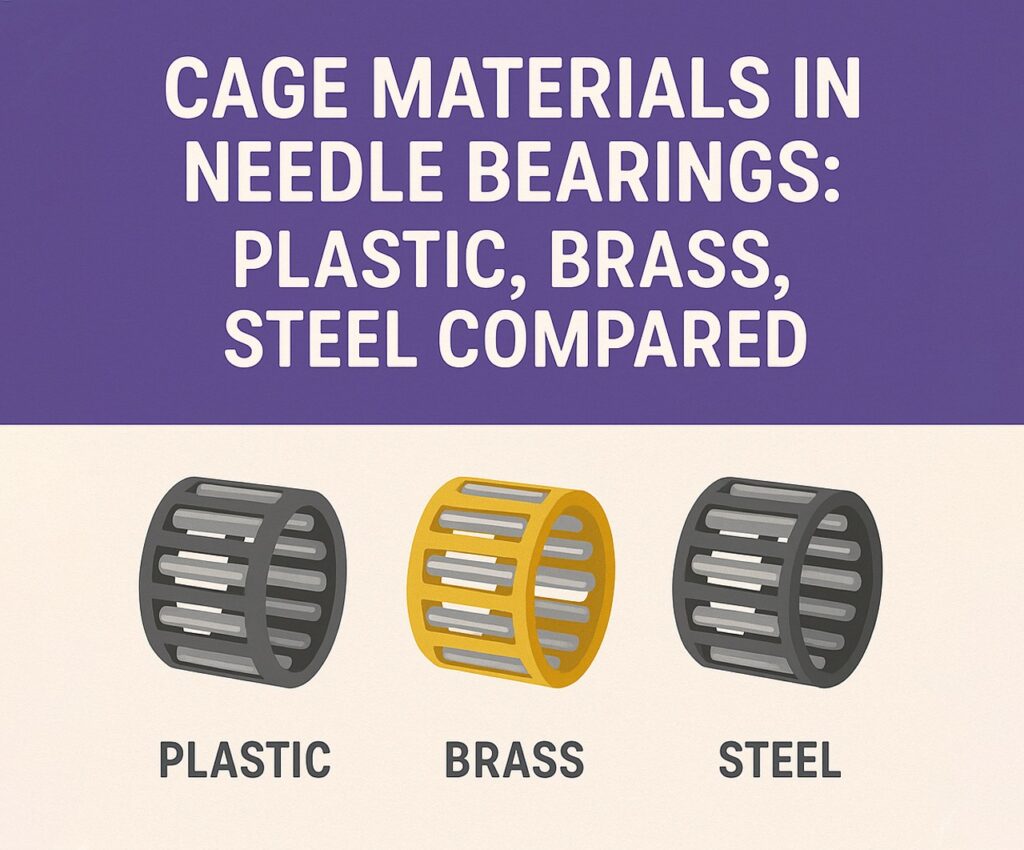When designing or maintaining high-precision systems, selecting the right needle bearing isn’t just about size and load capacity—it’s also about choosing the right cage material. Whether you’re working with caged needle bearings, handling loose needle bearings during custom assembly, or relying on sealed needle bearings for contaminant resistance, the cage material has a direct impact on performance, longevity, and suitability for specific environments. Each material—plastic, brass, and steel—offers unique benefits and trade-offs, and knowing when to use each can mean the difference between seamless performance and premature failure. Know More
What Are Needle Bearings?
Needle bearings are a subtype of roller bearings with long, thin cylindrical rollers that provide a high load capacity in a compact form. These bearings are especially popular in applications with limited radial space but high load demands, such as automotive transmissions, gearboxes, and industrial robotics.
Among the many variants, caged needle bearings, loose needle bearings, and sealed needle bearings dominate the landscape:
- Caged needle bearings use a cage to separate and guide the rollers, minimizing friction and extending service life.
- Loose needle bearings are individual rollers used in custom designs where precise placement or modification is required.
- Sealed needle bearings feature protective seals to keep out contaminants and retain lubrication, making them ideal for dirty or maintenance-limited environments.
Cage material plays a critical role in each of these configurations.
Why Cage Material Matters
The cage (or retainer) in a needle bearing keeps the rollers evenly spaced and guided. This prevents metal-on-metal contact, reduces heat, and maintains load distribution. The material used for the cage affects:
- Friction and wear rate
- Operating temperature range
- Chemical resistance
- Weight and inertia
- Speed capability
Whether you’re using caged needle bearings in an electric motor, sealed needle bearings in construction equipment, or configuring a custom setup with loose needle bearings, your cage material choice impacts everything from efficiency to maintenance cycles.
Plastic Cages: Lightweight and Quiet
Overview:
Plastic cages are typically made from materials like nylon, polyamide, or PTFE. These are often reinforced with glass fiber for added strength.
Pros:
- Lightweight: Reduces bearing mass, ideal for aerospace or high-speed applications.
- Quiet Operation: Naturally dampens noise and vibration.
- Corrosion Resistant: Performs well in moist or mildly corrosive environments.
- Low Friction: Reduces heat generation during high-speed operation.
Cons:
- Limited Temperature Range: Most plastics degrade above 120°C.
- Chemical Sensitivity: Can be degraded by some oils, fuels, and cleaning solvents.
- Lower Load Capacity: Not ideal for extremely high-load conditions.
Best For:
- Small sealed needle bearings in home appliances
- High-speed motors using caged needle bearings
- Lightweight machinery with low to medium loads
Plastic cages are often found in compact, enclosed systems where low noise and reduced weight are priorities.
Brass Cages: Durable and Stable
Overview:
Brass cages offer an excellent balance between strength, durability, and resistance to corrosion. They’re often used in higher-end caged needle bearings.
Pros:
- High Strength: Withstands shock loads and high radial forces.
- Corrosion Resistant: Handles water and oil exposure better than steel.
- Dimensionally Stable: Maintains form under heat and load.
- Machinable: Useful in customized loose needle bearing applications.
Cons:
- Heavier: Increases bearing weight, impacting inertia in dynamic systems.
- Higher Cost: More expensive than plastic or basic steel cages.
- Not Ideal for Ultra-High Speeds: Heavier mass increases friction.
Best For:
- Heavy-duty caged needle bearings in gearboxes
- Industrial equipment using sealed needle bearings under harsh loads
- Situations requiring vibration damping and impact resistance
Brass is a reliable middle-ground material, particularly when long service life and load consistency matter more than cost.
Steel Cages: Strong and Economical
Overview:
Steel is the most traditional and widely used cage material for caged needle bearings. It’s tough, wear-resistant, and readily available.
Pros:
- High Load Capacity: Excellent under high radial and axial forces.
- Thermal Stability: Handles temperatures above 200°C.
- Cost-Effective: Generally the cheapest option per unit.
- High Speed Compatibility: Works well in high-speed designs with proper lubrication.
Cons:
- Susceptible to Corrosion: Requires coatings or lubrication in wet environments.
- Noisy: Metal-to-metal contact increases operational noise.
- Heavier Than Plastic: May not suit ultra-lightweight builds.
Best For:
- High-load sealed needle bearings in heavy machinery
- Automotive transmissions with caged needle bearings
- Custom applications using loose needle bearings under high force
Steel cages are common in cost-sensitive, high-performance sectors like automotive manufacturing and industrial transport.
Cage Material Selection by Application Type
Automotive:
- Use steel or brass for gearboxes and drive trains
- Prefer sealed needle bearings for protection against road debris
Aerospace:
- Opt for plastic in weight-critical systems
- Use caged needle bearings with engineered polymers for silent operation
Agriculture and Construction:
- Favor brass or steel for durability in dusty, high-load environments
- Sealed needle bearings are essential due to dirt and moisture
Electronics and Robotics:
- Choose plastic for lightweight, low-friction needs
- Use loose needle bearings for custom assemblies with minimal load
Comparative Table: Cage Material Properties
| Property | Plastic | Brass | Steel |
| Weight | Light | Medium | Heavy |
| Max Operating Temp | ~120°C | ~250°C | ~300°C |
| Corrosion Resistance | High | High | Low |
| Load Capacity | Low | High | Very High |
| Cost | Low | Medium-High | Low |
| Noise Level | Very Low | Low | High |
| Machinability | Low | High | Moderate |
This breakdown is a quick reference for anyone evaluating cage materials in caged needle bearings, loose needle bearings, or sealed needle bearings.
Emerging Trends and Innovations
Advancements in cage materials and coatings are pushing the boundaries:
- Composite cages blend steel with polymer to combine strength with noise reduction.
- Ceramic-filled polymers offer higher temperature tolerance.
- PTFE-lubricated brass cages reduce friction without external oiling.
Such innovations are increasingly common in sealed needle bearings used in aerospace and medical equipment, where failure is not an option.
Maintenance Considerations by Cage Type
- Plastic: Generally maintenance-free but should be monitored for thermal degradation.
- Brass: Periodic inspection for wear; more stable over long durations.
- Steel: Requires regular lubrication and corrosion protection.
This is particularly critical in loose needle bearing setups, where cage and roller matching must be maintained.
Final Thoughts: The Right Cage Material for the Right Job
Choosing between plastic, brass, and steel cages isn’t a one-size-fits-all decision. It depends on your application, budget, load requirements, and environmental conditions. When comparing caged needle bearings, loose needle bearings, or sealed needle bearings, don’t overlook the cage material—it’s central to your bearing’s long-term success.
- Choose plastic for quiet, lightweight, low-load conditions.
- Select brass when durability and corrosion resistance are key.
- Opt for steel for high-load, high-temperature, cost-sensitive applications.
Understanding these differences will help you reduce downtime, increase efficiency, and get the most from your needle bearings, no matter the industry or application.

